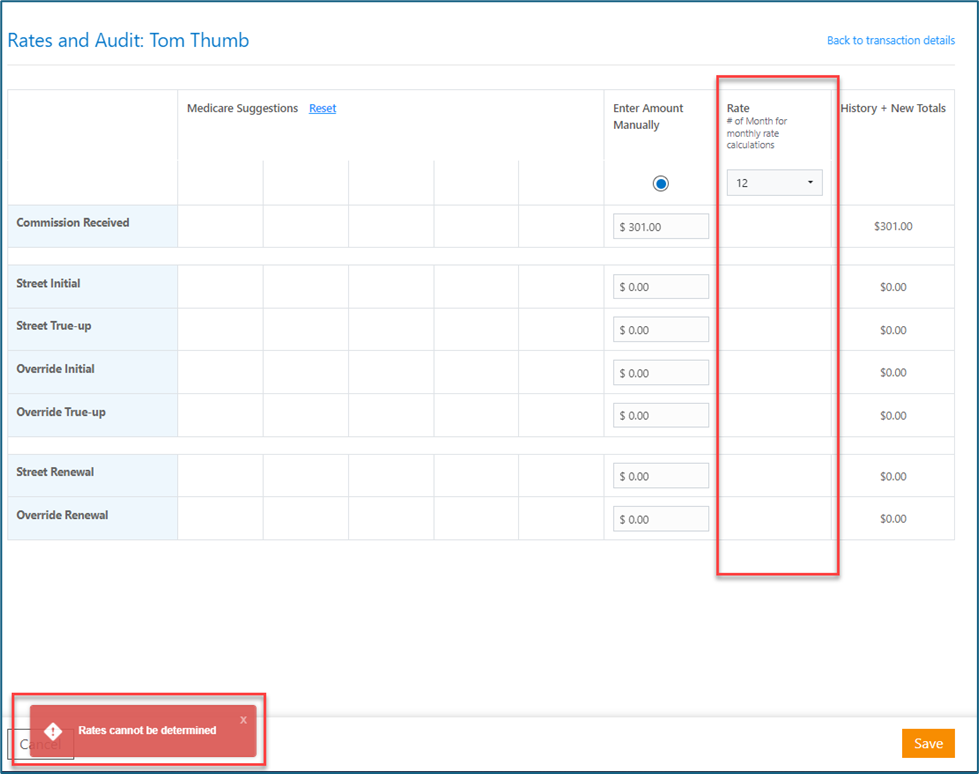Medicare allocating the Commission Received and Medicare Engine. Allocating Commission Received
Comissio processes commissions for each of the Street and Override fields independently.
Unfortunately, Carriers most often do not clearly define how the total Commission, which is stored in the transaction for Commission Received, needs to be allocated to the Street and Override fields. This document will first discuss from a logical view how allocation works and then will cover how the Medicare Engine helps to determine the allocation.
The following rates will be used in the examples for a MAPD Product.
Street Initial $270
Street True-up $269
Override Initial $96
Override True-up $54
Street Renewal $22.50
Override Renewal $5.42
This example will be after selecting Add New Transaction from within the Transaction History page in a Policy. If Add New Transaction were selected in the Transaction History page that is across Policies, the only difference is that the Policy number would need to be entered first. If the Transaction was added by an import, then the Medicare Engine will attempt to determine the allocation and present the best solution(s) for the Admin to review.
For full year commission amounts, allocating the amounts is easy to understand. If the commission received in the beginning of the year is $270, and there has not been a previous similar amount before, it is straightforward to see the amount needs to be entered in the Street Initial field. If a previous commission for $270 was received, and you receive a new commission for $269, then it should be easy to see it should go Street True-up. It is also should be obvious if commission received is $539 is received, that $270 should go in Street Initial and $269 go in Street True-up. Same logic would apply for full year commission received amounts for the Override Rates, or for combinations. So, if commission received is $366 and no previous commissions, then the amount to enter are $270 for Street Initial and $96 for Override Initial.
The following charts shows some examples of ‘If Commission Reved is $x.xx, then amount to put in the Street/Override ‘Buckets’ is $x.xx and is influenced when history is $x.xx:

For partial year amounts, where the Effective date of the Policy is not the beginning of the year, it gets only a little more complicated. If the Policy starts 7/1/2023 then the numbers to calculate to allocate usually are prorated as you would expect. If you receive an amount ½ (6/12) of the full rate in the different combinations, then you can allocate the halved amount in the respective Street/Override fields.
For mixed partial year and full year amounts, it is even more complicated as an Admin would need to recognize something like $231, that should be $135 (6 months) of Street Initial, and $96 (full year) Street Override. Fortunately, commissions of this type are not common, but do occur. An admin with prior experience and time can figure out the right allocation, but it is not a painless process.
The Medicare Engine will manage all three of those scenarios and produce the ‘right’ answer or display alternatives and make it easy for the Admin to choose what they believe is correct.
Once the Street/Override fields are allocated/populated, the commission cycle will pay out commissions correctly according to the field that is populated.
For amounts that do not match up and for corrections, it can be very complicated. Sometimes a call to the Issuer is needed to clear up what the commission received amount is meant to entail. At times, Issuers pay incorrect amounts, like last year’s rates or for a different/incorrect Plan. The commissions are best paid out to the Agents by splitting up the amounts to the fields according to what is believed to the best Street and Override amounts. Then usually the Issuer will send a correction in the form of the previous commission amount except a negative amount and send a new record with the correct commission amount. So, a simple example would be if the Issuer paid $250 (last years or another products Street Initial Amount) so the Admin enters $250 in Street Initial. The Writing Agent would receive $250. Then for that same Policy, in the next Carrier Statement the Admin receives a new commission for -$250 and a new commission for $270. For these respective commission received amounts, the admin would enter -$250 in Street Initial for the first, and then $270 for Street Initial for the second. (Might be helpful to add a note to the transaction for some unusual situations.)
Corrections are managed by negative amounts. So, if a Policy started in the beginning in the year is canceled in the middle of the year, the Issuer may send a negative commission received amount to pay back remaining months. So, for example the full year number of commissions for all Initial and True-up fields was paid. Then the Policy is cancelled mid-year. The Issuer may send a negative commission amount for half a year’s commission that would need to be allocated to the correct Street/Override fields. The Medicare Engine will also calculate the allocation of these amounts as well.
Medicare Engine
The Medicare Engine is a name given to a process that uses the Commission Received amount in a Transaction and calculate the correct allocation to the Street and Override fields based on the top-level rates for the Commissionable Product of the Policy. The process runs automatically after an import of Transactions for Policies with the Medicare Advantage and Medicare Prescription Product Type. A page to Show Rates and Audit is used to show alternate allocation combinations, history, and rate details. The Show Rates and Audit page can also be used to manually trigger the Medicare Engine process.
Commission Distribution in a Medicare Policy with the top-level Contracts rates outlined
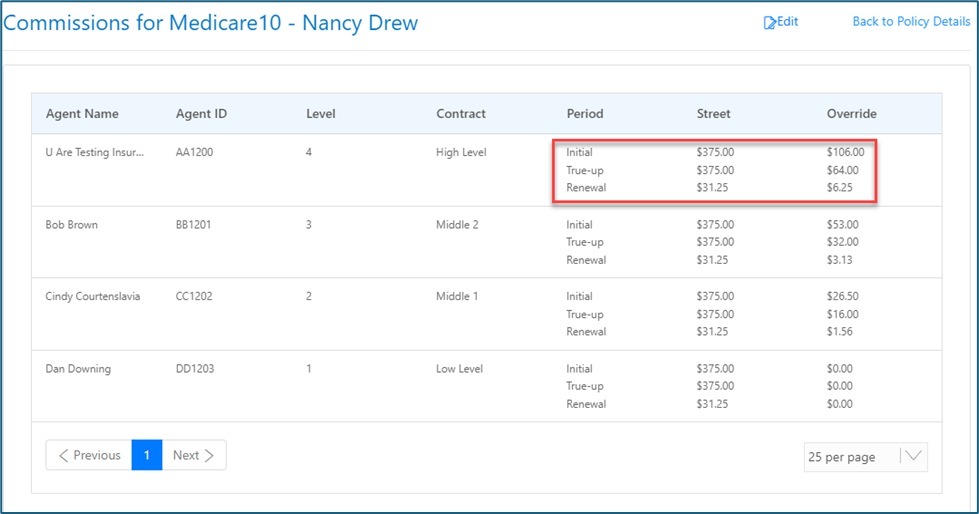
The Commission Received from an Issuer should equal those rates or a pro-rated amount based on those rates.
Examples based on those rates.
If $920 is received, the system will know to allocate $375 to Street Initial, $375 to Street True-up, $106 for Override Initial, and $64 for Override True-up.
When a transaction is manually created, and the Street and Initial fields are not allocated, the status will be unallocated.
Transaction details before allocation with link to Show Rates and Audit link outlined
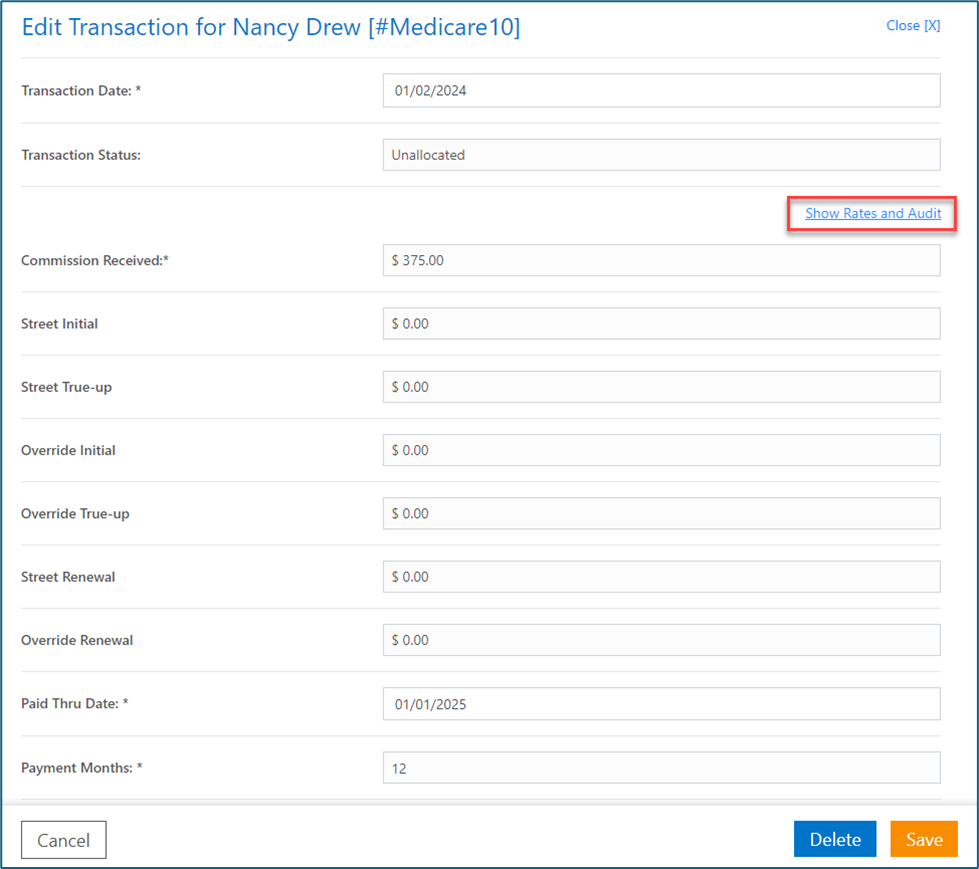
Rates and Audit page prior to using the Medicare Engine.
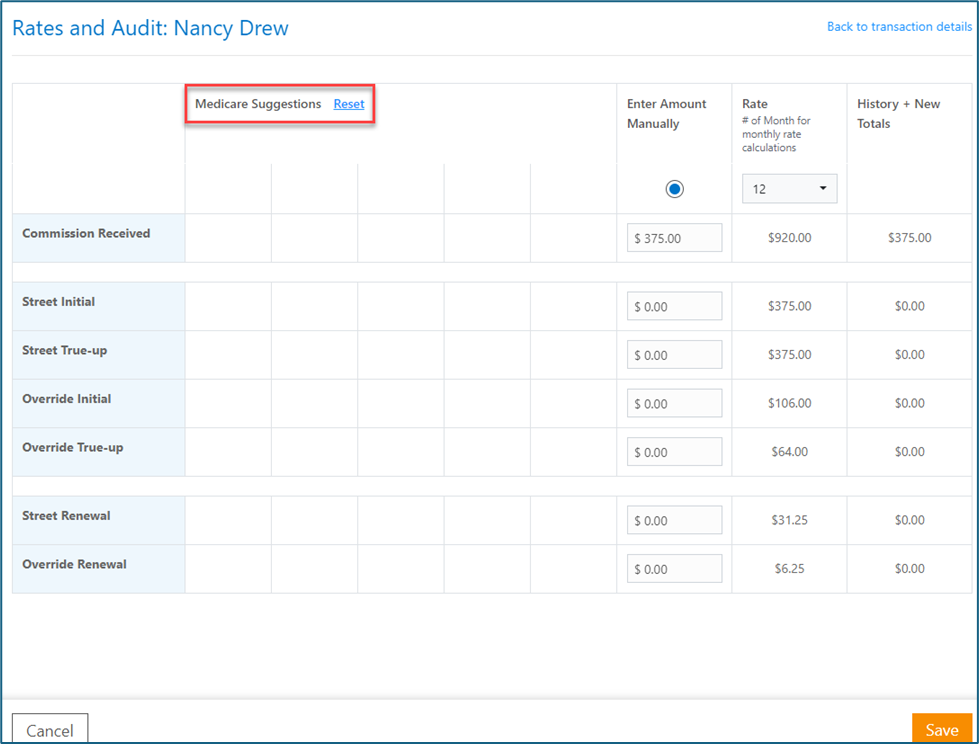
Medicare Suggestions Reset manually triggers the Medicare Engine to run. After selecting Reset, matching allocations will show in the columns below the option.
The column for Enter Amount Manually will allow the admin to enter values.
The column for Rate defaults to 12 months to show the full year rate for the Initial and True up rates. Renewal Rates are displayed as the monthly Rate. The number of months and displayed Initial and True-up rates in this column do not dynamically change to the rates entered or determined by the Engine, but the months value can be changed by the admin for them to reference prorated amounts for each field.
The column for History + New Totals shows totals using other Transactions for the Policy which helps what has been previously allocated or paid in comparison to amounts in the current Transaction.
Rates and Audit page after selecting ‘Reset’ with the selection for the recommended allocation outlined
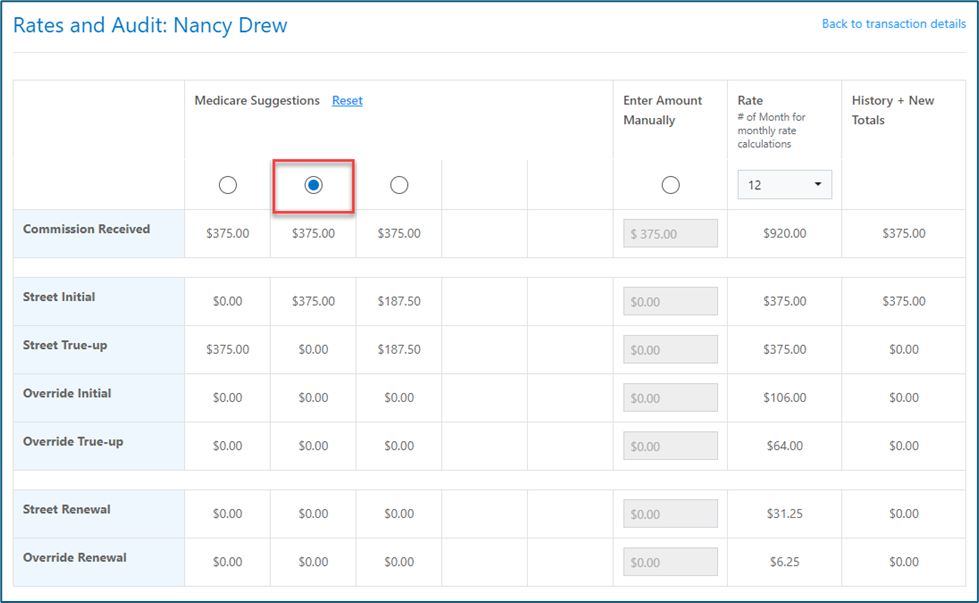
Pro-Rating Example:
In the example above, the effective date of the Policy is 1/1/2024. If the Effective Date of the Policy is changed to 7/1/2024 and Reset selected, the recommended allocation shows allocation amounts that equal 6 months in Street Initial and Street True-up.
After changing the Effective Date of the Policy to 7/1/2024 - Rates and Audit page after selecting ‘Reset’ with the selection for the recommended allocation outlined
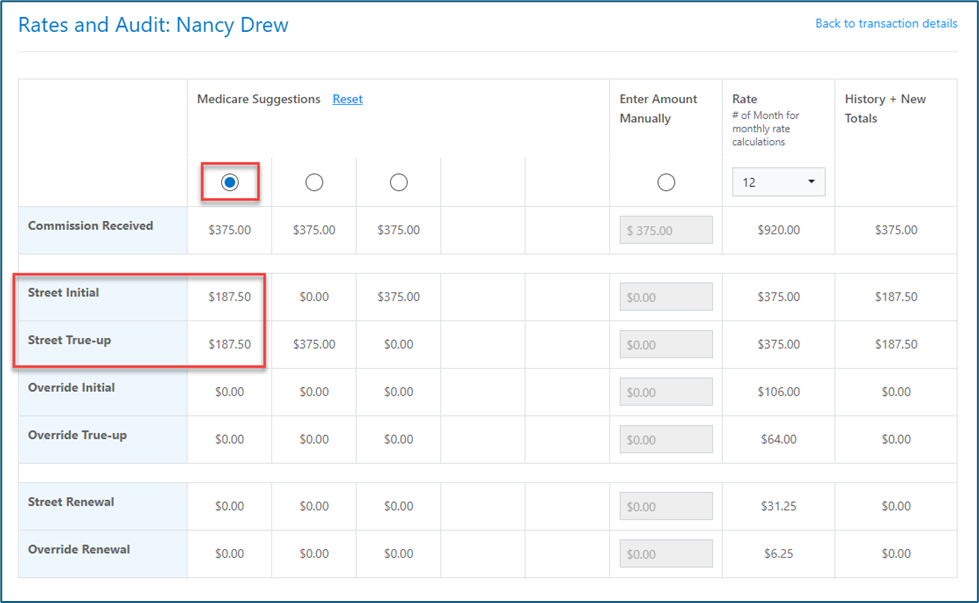
Renewal example:
The system looks at the Paid Thru Date in relation to the Effective Date of the Policy to determine if it should be for Renewal Rates. When the Paid Thru date is the next year, one month will come up as a renewal amount.
Rates and Audit page with PTD 2/1/2025 (next calendar year) matching to renewal rates
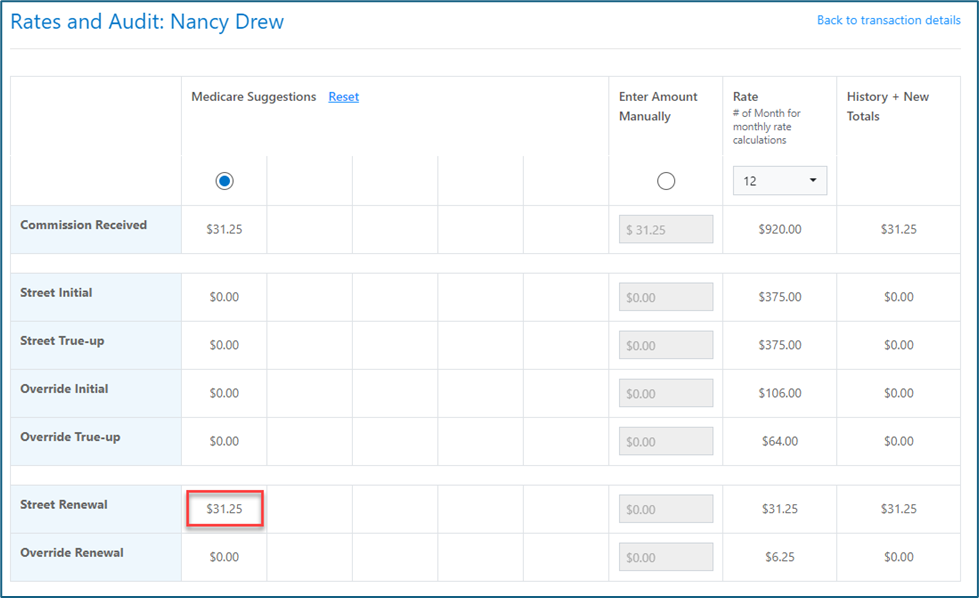
Rates and Audit page with PTD 12/31/2024 (same calendar year) matching to Initial/True-up rates
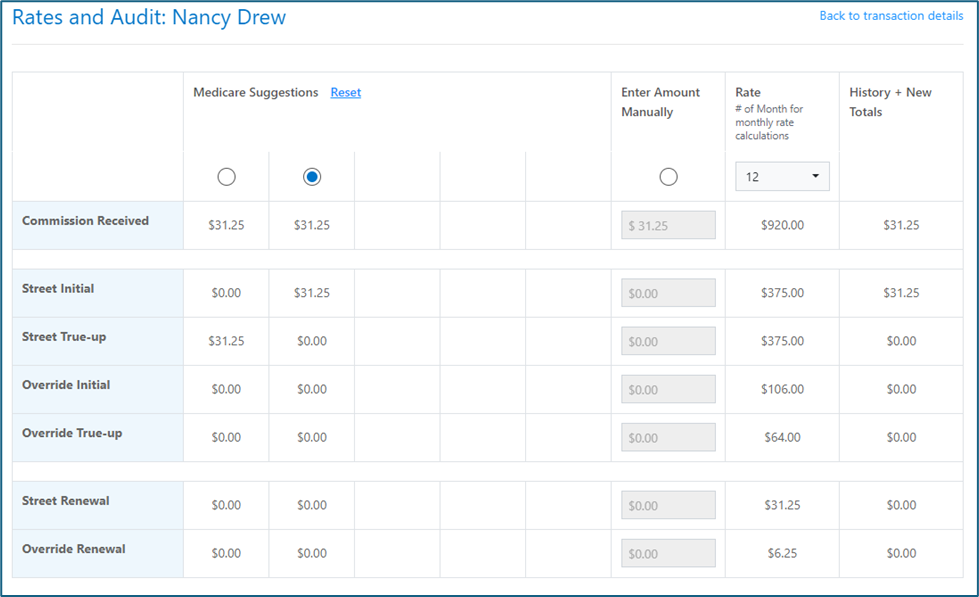
Negative Commission Received amounts are allocated to the Street and Initial fields in a comparable way but with corresponding negative values. The commissions generated in the cycle would then be negative.
Rates and Audit page with Negative Commission Received example
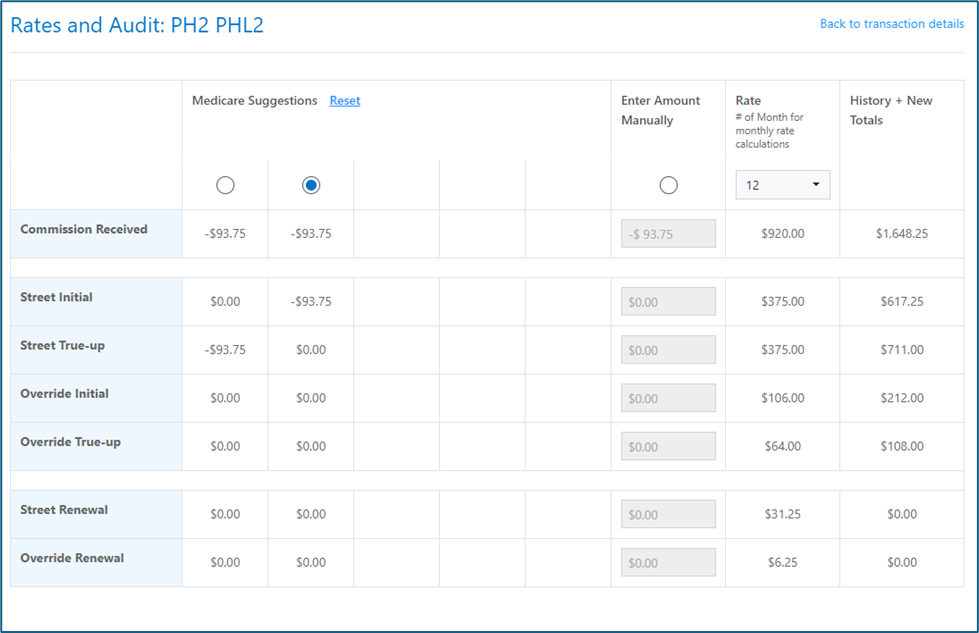
Unallocated Status: If a transaction for a Medicare Policy is manually created and the Medicare Engine not manually activated, or if the Medicare Engine cannot determine one solution, the transaction will be in Unallocated Status. The admin will need to review these to determine the values or any correction needed.
No Suggestions provided: In any situation where the Medicare Engine cannot create any Suggestions it means the amount provided does not divide cleanly into the rates in the Policy. The admin will need to do further research to determine if the rate in the Policy is incorrect or if the Commission Received amount paid by the Carrier is incorrect. Looking at the history of Commission Received and amounts paid to the respective Street and Override fields can help with this research.
An Override is allowed so Commission Received can be saved to not match allocation
Commission Received and the sum of the Street and Override fields should match, but the system does allow it if the admin wants to override that for their own purposes, for example to may more than what was paid. In that case, a popup will ask “The Commission Received amount does not equal the amount allocated in the Street and Override fields, do you want to save anyway?” A similar type of warning will come up if using the Transactions MAPD & PDP import and the values entered in the Street and Override fields do not match the Commission Received. If it was not intentional, the admin will need to correct the transaction.
Rates and Audit page displaying message asking to save anyway even when Commission Received and allocated amounts do not equal each other
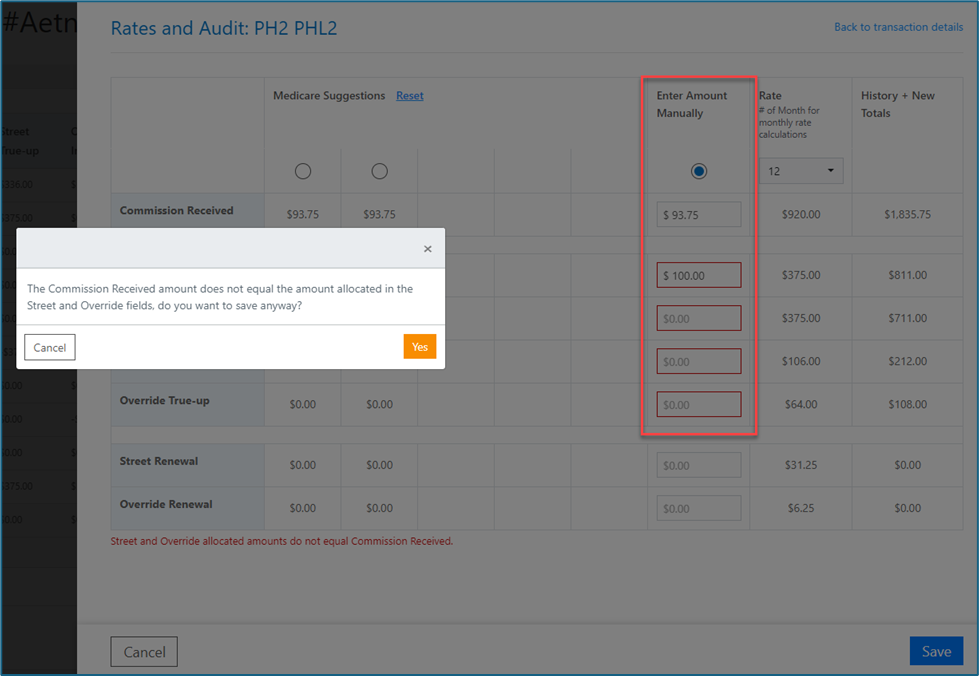
Commission Distribution and Medicare Engine
The Medicare Engine uses the top-level Plan Rates from the Commission Distribution. If there is no Commission Distribution, then the system cannot calculate what is needed for the allocation.
The primary reason if a Commission Distribution is not showing values, is that Commission Plan Rates are not set up for the contract of at least one of the Agents for the Product in the Policy. It can also be if the Plan Rates for the Product have been created but do not cover the effective date of the Policy.
Another reason for the Commission Distribution being blank is that it is for a Policy brought over from a legacy system as part of the Book of Business transfer, and the intention is not to enter the old rates. In this case, what is needed is the Commission Distribution information needs to be created directly, either manually or by import, to bring in the corresponding hierarchy and rate information the same as what was in the legacy system.
When the Commission Distribution is blank, when going to the Rates and Audit page, a message will display that ‘Rates cannot be determined’ and the column for rates will be not populated.
To fix the issue where the Commission Distribution is blank, look for the Product in the Policy. Then confirm the Commission Plan Rates are created for the contract associated with each Agent for the date of the Policy for that Product.
Rates and Audit page with error message and blank rates column outlined:
